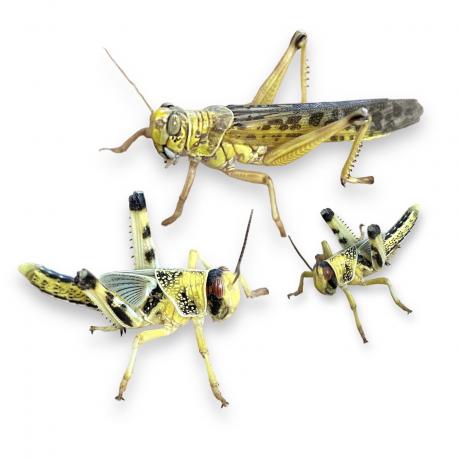

Locusts or Hoppers are an ideal staple food for all a wide range of species. Particularly popular for slower moving or arboreal reptiles. These insects are available in 6 different sizes.
Young locusts are vibrantly coloured with yellow and black speckles and banding, whereas mature adults go pink and brown in colouration, with large transparent wings, growing to a body length of up to 60mm. Locusts of all ages move fairly slowly, but if startled can use their powerful jump to move away quickly. Only the adults are capable of flying, but in captivity, the lack of room to do so means that they will glide at best.
Primarily found in dry, desert areas of Africa, Arabia and southwest Asia. Likely to have spread further because of its popularity as a feeder insect and its ability to travel long distances.
Our Locusts are bred in a modern, ethical facility, reared on high end food; meaning that they arrive to you fresh and in excellent health.
If temperatures are low on arrival, your Locusts may appear immobile - but they will soon become active when warm again. Your Locusts will arrive in ventilated pre-pack tubs (or hessian bulk bags depending on the quantity you have ordered) with cardboard inside to increase the usable space within the tub and bran to keep them dry.
Storing at room temperature around 15-24°C is perfect for this species.
In order to get the best from your Locusts, we recommend that you move them into larger, well ventilated, species specific tubs (i.e don’t mix Crickets and Locusts) Offering the insects more space makes feeding and watering them much easier, it keeps them alive for longer and conveniently, makes them easier to catch.
For at least 24 hours prior to offering them as prey we recommend gut loading and hydrating your feeder insects. Prior to feeding them to your animal, feed the insects nutrient rich foods, this ensures maximum nutrition is being transferred from your Locusts to your pets. Dehydrated insects will not readily absorb nutrients and become weak and lethargic, prematurely dying off. For feeding, salad leaves and apple offers basic nutrition and moisture. The best option however is to offer them one of the specialist high quality insect diets; It makes perfect sense that well fed, hydrated feeder insects are far healthier and more nutritious for your pet.
This species is high in protein and low in fat, making them a nutritious staple food for your exotic pets (especially when Gut Loaded and dusted with calcium and multivitamins).
Locusts are well suited to a variety of vivarium and terrarium conditions. They are slow moving, and also like to climb, making them ideal for many arboreal species such as chameleons and frogs. It is worth noting that locusts will eat live plants, so care must be taken to only feed as many as your animal will eat in one sitting.
They are available in a variety of sizes to cater for the nutritional requirements of species at different weights and stages of development. Adult Locusts are an excellent size for larger reptiles. For keepers of larger monitor lizards, buying these in bulk is a cost effective way of keeping larger pets well fed on a healthy diet.
We advise researching the dietary needs of your pet (or contacting us if you need advice) to determine the size and quantity you feed as this is entirely species and age dependent. An abundance of uneaten prey items will potentially stress out your reptile and can cause possible issues during moulting (especially for invertebrates).
We recommend feeding Locusts as part of a wider varied diet, as with any livefood, variety is the key to providing a well balanced, nutritious diet. To compensate for eating a less varied diet than their wild ancestors, we recommend the addition of calcium and vitamins to enhance the nutritional content of these insects. The easiest method for coating your livefood is to put a little supplement powder in a zip-lock bag, add the insects and gently shake. Use some forceps to transfer the livefood into your enclosure. This way, you are not wasting your supplements and only dusting the insects needed per feed.